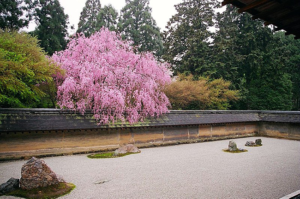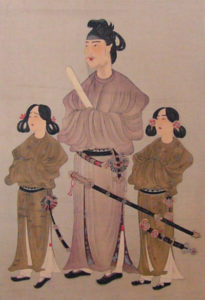Teaching Japanese Culture: Timeless Influences
At the most fundamental level, no humans have created cultures that are completely unique in human history. That said, indigenous practices, interactions with other cultures, and subsequent creative cultural adaptations help to richly enhance any culture. Each one of the following archived EAA articles, intended for teachers and students, are illustrative of cultural practices and influences that remain “timeless” in influencing many Japanese.
Emiko Ohnuki-Tierney in “Rice as Self: Japanese Identities Through Time” (volume 9, number 3, winter 2004) begins with the introduction of wet-rice agriculture to peoples of the Japanese archipelago in approximately 400 CE and concludes in the early twenty-first century. The author provides multiple examples ranging from creation stories to the formation of governing institutions, art, literature, and trade policy that demonstrate rice’s profound cultural influence in Japan. In an NCTA institute I coordinated shortly before the publication of this column, a geographer used photographs to illustrate how in much of Japan, rice production patterns are critical in understanding Japan’s cultural landscapes.
Linda Chance’s essay “Colors of Japan: Literature Comes to the Table” (volume 21, number 3, winter 2016) focuses upon the written accounts of a few Japanese women from around the year 1000 CE in the Heian Period who created color combinations that still culturally manifest themselves today in Japan. Some examples include Japanese preferences for formal banquet cuisine, seasonal food choices, and Hello Kitty attire.
Fay Beauchamp in her feature article “From Creation Myths to Marriage Alliances: Shakespeare’s The Tempest and Murasaki’s Akashi Chapter” (volume 6, number 1, spring 2001) intended for high school and first-year college humanities and comparative literature courses does a superb job in recounting how she introduced her Community College of Philadelphia students to two literary works: Shakespeare’s The Tempest, and a critical chapter from Murasaki Shikibu’s Heian Period work, The Tale of Genji. Both examples from these literary works feature similar plots—terrible storms, love affairs, aristocrats, and the supernatural—and students compare and contrast Western and Japanese cultural values that exist in The Tempest and The Tale of Genji, and continue respectively to influence different cultural perspectives today. The author’s inclusion of her student reactions to both works and how they changed in the course of reflecting upon their initial reactions are particularly useful in planning this or similar comparative cultural teaching.

Source: Wikimedia Commons at http://tinyurl.com/hxbzg7m. Photo by Didier Moïse.

Source: Wikipedia at https://tinyurl.com/ycg7k95m.
Seven Tennessee middle and high school master teachers, selected through a Freeman Foundation NCTA grant, spent fourteen months working with the UTC Asia Program in the development of fourteen classroom-tested teaching modules on East Asia-related topics that appear in significant numbers of state and local private and public school curricula. Since the publication of the modules in late 2018, over 14,000 unique visitors have used these digital teaching materials.
This article was published as part of the June 2021 EAA Digest.

